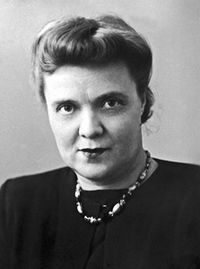Elena Skuin facts for kids
Quick facts for kids
Elena Petrovna Skuin
|
|
|---|---|
 |
|
| Born |
Jeļena Skujiņa
April 2, 1908 Ekaterinodar, Kuban Oblast, Russian Empire
|
| Died | February 12, 1986 (aged 77) |
| Nationality | Latvian |
| Education | Repin Institute of Arts |
| Known for | Painting, Art teaching |
| Movement | Realism |
Elena Petrovna Skuin (Russian: Еле́на Петро́вна Скуи́нь, Latvian: Jeļena Skujiņa) was a talented artist and teacher. She was born on April 2, 1908, in Ekaterinodar, Russian Empire. She passed away in 1986 in Leningrad, USSR.
Elena Skuin was known for her paintings, especially her beautiful still lifes. She also worked with watercolors and graphic art. She was a member of the Leningrad Union of Artists and is considered an important part of the Leningrad School of Painting.
Her Life as an Artist
Elena Petrovna Skuin was born into a family of teachers. Her family had moved to Kuban from Riga. After finishing high school, she studied at the Kuban Teachers College from 1926 to 1930. This is where she first learned professional painting skills. From 1930 to 1931, she taught drawing in a high school in Krasnodar.
In 1931, Elena Skuin moved to Leningrad. She first worked as an artist at the Stalin Metalworks. Later, she continued her art education at a special institute for art workers.
In 1936, Elena Skuin joined the painting department at the Leningrad Institute of Painting, Sculpture and Architecture. She learned from famous artists like Rudolf Frentz. In 1939, she finished her studies in Alexander Osmerkin's art studio. Her final project was a painting called "Lesson of the circle, studying the Naval Science." This type of painting, called genre painting, shows scenes from everyday life.
In October 1939, Elena Skuin became a member of the Leningrad Union of Soviet Artists. This was an important group for artists. From 1940 to 1941, she worked as an assistant in Rudolf Frentz's studio at the Institute.
When World War II (called the Great Patriotic War in Russia) began, Elena Skuin and her daughter moved to Kazakhstan for safety. There, she worked as an artist for a drama theater. She also helped design parts of the city and showed her art in local exhibitions.
Returning to Leningrad and Teaching
In 1944, Elena Skuin returned to Leningrad. She started teaching art, first at the Secondary Art School connected to the Repin Institute. Then, she taught at the Vera Mukhina Institute. While teaching, she also created many artworks and showed them in exhibitions with other Leningrad artists. She painted different types of art, including genre paintings (everyday scenes), portraits (pictures of people), still lifes (pictures of objects), and landscapes (pictures of nature). She used oil paints, watercolors, and charcoal. She became most famous for her still life paintings and watercolors.
In 1951, Elena Skuin stopped teaching to focus on her own art. She began working on art projects through contracts with a commercial art association. During this time, still life became the most important type of painting for her. Her still lifes from this period often showed flowers and fruits. They were colorful and carefully arranged, celebrating the joy of life.
Developing Her Style
In the 1960s, Elena Skuin traveled to find new ideas for her paintings. She even visited her home region of Kuban. These trips inspired many new artworks, like "Tobacco of Kuban" and "In horticulture" (both from 1962). Her painting style also changed. She started using brighter, more decorative colors instead of softer, more traditional tones. Her paintings became known for their strong, bright colors and broad brushstrokes. They often had a cheerful and decorative feel.
A highlight of her decorative painting style came in 1971 with works like "Dark-blue buckets" and "Still Life with red balloons." In these paintings, colors were very important. They helped show the shape of objects with simple outlines. This simple style created many feelings and ideas. Ordinary objects took on a special, almost magical meaning through her use of color.
Some of her other famous paintings from this time include "Still Life with Quince" (1961), "Begonia" (1964), "Violets" (1965), "Blue Still Life" (1968), and "The Apple Tree in Blossom" (1980).
In the 1970s, Elena Skuin also created many beautiful watercolors. Works like "Still Life with bluebell" (1969) and "Old English china and pineapple" (1971) show her skill with watercolors. She used different watercolor techniques to create vivid and memorable images of everyday objects, showing their beauty and warmth.
Elena Petrovna Skuin had solo art shows in Leningrad in 1978 and in Saint Petersburg in 2005. She passed away in 1986. Her paintings are now in important places like the State Russian Museum. You can also find her art in other museums and private collections around the world, including in the U.S., Japan, Germany, England, and France.
See also
 In Spanish: Yelena Skuin para niños
In Spanish: Yelena Skuin para niños
- Leningrad School of Painting
- List of 20th-century Russian painters
- List of painters of Saint Petersburg Union of Artists
- Saint Petersburg Union of Artists

